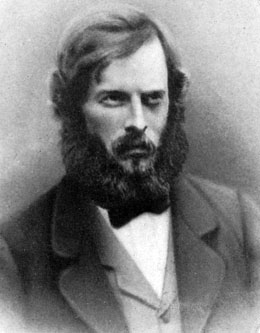On August 21, 1853, Theodore Winthrop (1828-1861) finishes a tour of Washington Territory at Port Townsend on the Olympic Peninsula. He has toured the territories of California, Oregon, and British Columbia. As he turns toward his New York home, he is in great haste to meet members of his traveling party at Fort Dalles, the U.S. Army outpost on the Columbia River. He hires members of the S'Klallam tribe and their canoe to take him down Puget Sound to Fort Nisqually. There he buys horses from Owhi, a Yakama Chief, and hires Owhi's son Lo-kout to guide him along the treacherous Naches Trail that crosses the Cascades. Winthrop and Lo-kout have a falling out, and Winthrop finishes the journey alone.
Theodore Winthrop, a descendent of John Winthrop (1588-1649), the first governor of the Massachusetts Bay Colony, graduated from Yale College in 1848. He toured the European continent, clerked in Panama, and spent five months in Washington Territory. There he contracted smallpox and had to languish in a cabin for several weeks of quarantine. He wore a full red beard and weighed 126 pounds. In 1890 the town of Winthrop would take his name, and so would the Mount Rainier glacier he described in his 1862 travel narrative The Canoe and the Saddle, a book that is the foremost source of information about his movements through the Territory.
The Canoe
By August 21, 1853, Winthrop was ready to depart from Washington Territory and head toward his New York home. In six days, with the help of Native American paddlers and guides, he needed to travel the length of Puget Sound and cross the Cascades in order to join a wagon train leaving from Fort Dalles. At Port Townsend he hired a 40-foot dugout canoe and paddlers. They agreed to carry him 85 miles down the Sound to Fort Nisqually near the present site of Tacoma. He wrote:
"My vessel was a black dug-out with a red gunwale. Forty feet of pine-tree had been burnt and whittled into a sharp, buoyant canoe. Sundry cross-pieces strengthened it, and might be used as seats or backs. A row of small shells inserted in the red-smeared gunwale served as talismans against Bugaboo" (Winthrop, 20).
The passage is characteristic of Winthrop's writing in The Canoe and the Saddle, where his anthropological observations often mingle with his ethnocentrism.
The owner of the canoe and a member of Winthrop's retinue was Chetzemoka, a chief of the S'Klallam Indians. Settled in Chetzemoka's craft, urging his paddlers to pull hard to earn the blankets he would pay them, Winthrop noticed them drinking rum. He disapproved. And so in the interest of efficiency and speed, he risked a mutiny, confiscated the rum, and poured it overboard. The Indians rebelled. He brandished his Colt pistol and ordered his paddlers to turn back to their task.
And the Saddle
Arrived at Fort Nisqually, Winthrop purchased horses and retained an Indian guide to take him to Fort Dalles. The man who sold him the horses was Yakama chief Owhi (d. 1858). The guide was one of Owhi's sons, whom Winthrop knew as Loolowcan. Inasmuch as no other record of that name appears in regional histories, one may conclude with A. J. Splawn that Winthrop's guide was Lo-kout, a brother of Qualchan (d. 1858).
The traverse across the Cascades on the Naches Trail was arduous and rushed. After a windy night spent on river rocks, Winthrop kicked Lo-kout to hurry him from bed. Later that day his guide abandoned him, and Winthrop finished the overland voyage on his own. Lo-kout, after seeing his brother Qualchan hanged by Colonel George Wright (1803-1865), and after taking Qualchan's widow, Whist-alks, as his wife, enrolled in the Spokane tribe as L'Quoit. He outlived Theodore Winthrop by five decades, for Winthrop joined the Union cause and died in an early battle in the Civil War. In New York, between 1853 and 1861, Winthrop wrote five books, published posthumously.

